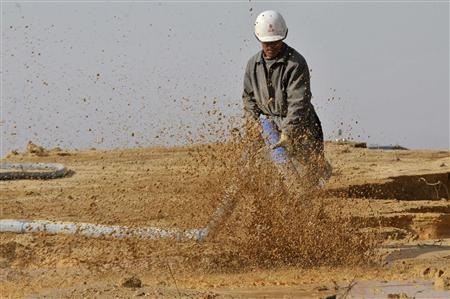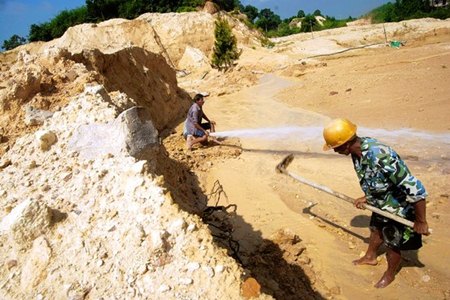Rare earth mining and risk of pollution
Because of China's reduction in rare earth exports, many countries, especially Japan, are forced to find other supplies and this is an opportunity for Vietnam to exploit this resource. But rare earth mining also contains a lot of environmental risks.

A type of rare earth mining
Rare earths and rare earth metals are a collection of 17 chemical elements of the Mendeleev Periodic Table, called scandi, yttrium and 14 in 15 of the Lanthanum group. In particular, yttri comes from the name of Yterby village (Sweden) - where this ore was first discovered, and scandi is from Scandinavia.
Rare earths are used in making many products such as microphones, speakers, headsets, music devices, computer hard drives, in fiber optic telecommunications, LED display technology, printing and money technologies. Semiconductor technology, superconductivity .
Due to special physical and chemical features, over the past four decades, rare earth materials have become the subject of research inventing many technical applications from macro to micro and nano for many industries. different: chemical catalysts in the oil refining industry, pollution testing in the car industry, ceramic liners for jet engines, permanent magnets for magnetic applications . There are groups for fluorescence and condensation industry especially for liquid crystal displays. There is a group for permanent magnet technology in electrical, electronic devices, audiovisual media, computers and multi-gigabyte disks today. There are groups to produce extremely strong magnetic moments used in magnetic cooling techniques.
In the future, rare earths will be needed for the production of hydrogen fuel tanks and pipes, when the world runs out of oil.

Rare earth mining in China
The reason China is now becoming a source of 97% of the world's rare earth because many other countries realize that mining is expensive, causing great harm to the environment. Since the 1950s, monazite mining has been exploited on beaches; but this rare earth phosphate mineral contains a lot of radioactive thorium, so since 1965 it has switched to exploiting bastnasite rare earth carbonate in the mountainous Pass, Colorado state, USA.
Later, in part due to the high costs of rare earth mining and other concerns of environmental impacts, Western countries (in particular the US) suspended production of rare earth to rely on resources. Abundant and cheap supply from China. That dependency has enabled China to monopolize monopoly in the rare earth field. Until 2009, China accounted for 97% of the world's rare earth exports .
However, China's rare earth reserves account for only 1/3 of the world's reserves. Many rare earth mines are being developed in Australia, Canada and in the United States. Many other countries also have large reserves of rare earths such as in Russia, India, Brazil or Mongolia. On January 3, US online magazine Money Morning reported that a country's mining company had discovered the world's largest known rare earth mine.
Vietnam is also one of the countries considered to have high reserves of rare earth. So, some countries like Japan are turning to Vietnam for additional supplies.
According to AFP , two Japanese companies, Toyota Tsusho and Sojitz, are cooperating with Vietnam Coal and Mineral Group (Vinacomin) to prepare for exploiting rare earth mines. Sumitomo and Toyota Tsusho-Sojitz projects are expected to exploit at least 7,000 tons of rare earth each year, equivalent to 20% of Japan's demand. The initial investment for these two projects is about USD 200 million.
In Vietnam, the preliminary survey and search for minerals said that the rare earth reserve is estimated at 10 million tons, including all groups of 17 elements. Vietnam has both rare earth mines, including Mountain Pass stones in ancient stone foundations in Son La, Lai Chau, Yen Bai and in the black sand banks of the central coast. Selling prices of rare earth metals are quite high. In 2003, the price per kg of lanthanium metal was US $ 25 and cerium was US $ 30. Rare earths are processed into commodity products with very high commercial prices. In 2008 Europium was 99.99% pure and cost about $ 221,000 / kg, Terbium USD 145,000 / kg
The exploitation of rare earths in Vietnam does not cause sensitive issues like bauxite mining, especially the exploitation of ore circuits in ancient rock because the area of mining mines will not be as large as the exploitation of bauxite. Currently, Vietnam still lacks modern processing technology and does not have enough investment capital to scale, so it can only cooperate with other advanced technology countries, to gradually continue. collecting technology needed for the development of rare earth industry.
However, the exploitation and processing of rare earth is much more likely to cause environmental pollution than the exploitation of other minerals such as coal and oil because rare earth processing must use a lot of chemicals affecting the environment. . In addition, rare earth minerals have radioactive minerals with higher intensity than other minerals. That is, exploitation and processing of rare earth contain two risks of pollution: pollution of chemicals and radioactive contamination from rare earths. Thus, the question is to protect the health of exploiting workers , the health of the people in the mining area and restore the environment after exploitation.

Hazardous waste water discharges into the Yellow River .
Even China is now preparing to issue new regulations to combat environmental pollution caused by rare earth exploitation. According to China Daily, issued in early January, China's rare earth mining companies will be ordered to within 2-3 years comply with new environmental pollution standards. Specifically, according to the regulations that will be issued after the Lunar New Year holiday, waste water used in rare earth mining should not contain more than 15 mg of ammoniacal per liter compared to 25 mg today. Radioactive and phosphorus substances must not exceed the prescribed levels.

. and causing serious environmental pollution
China's restriction on rare earth exports is actually aimed at concentrating manufacturers to better control polluting wastes. Thus, the most infected small producers will have to close. Hundreds of small factories producing rare earths in Baotou City, Inner Mongolia and China, have so far blamed these wastes on the Yellow River, because there are no strict regulations on this.
A report in 2005 wrote: ' In Baotou, where nearly 150 million people depend on the water supply of the Yellow River, all fish die. Many people in their 30s work near rare earth mines that have died of cancer, most likely due to radiation contamination . '
- Having rare earth is still difficult to get rich
- Japan is allowed to exploit rare rare earths in the Pacific
- Listening to an expert explaining that 'rare earth is not as rare as the name'
- Rare earth in the seabed
- Composition and effects of rare earth
- Things you do not know about rare earth
- Rare earths are threatening technological development
- Vietnam - Japan: Cooperation in rare earth mining
- Recovery of rare earth from waste water
- The truth about metal helps China grow fast but also gradually destroys this country
- Greenland allows the exploitation of uranium and rare earth in the Arctic
- Japan discovered rare earth mines on the ocean floor
 Is the magnetic North Pole shift dangerous to humanity?
Is the magnetic North Pole shift dangerous to humanity? Washington legalizes the recycling of human bodies into fertilizer
Washington legalizes the recycling of human bodies into fertilizer Lightning stone - the mysterious guest
Lightning stone - the mysterious guest Stunned by the mysterious sunset, strange appearance
Stunned by the mysterious sunset, strange appearance